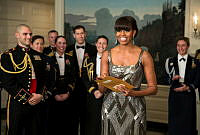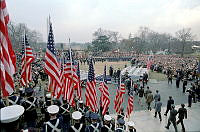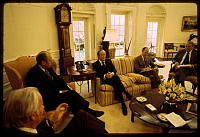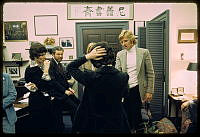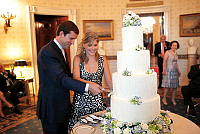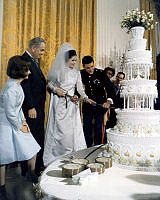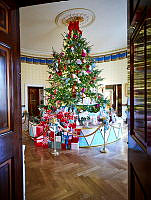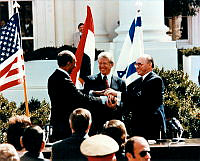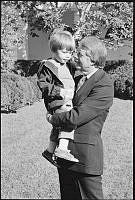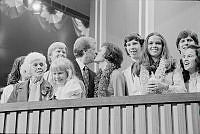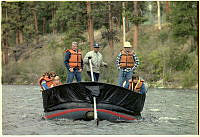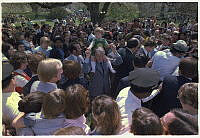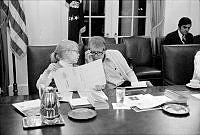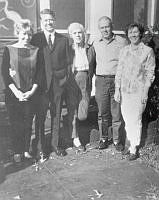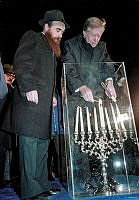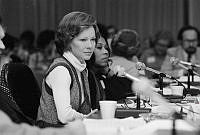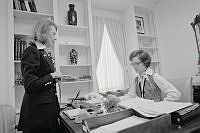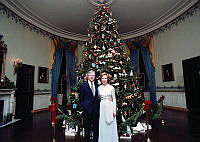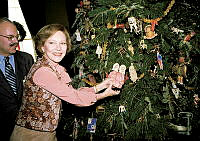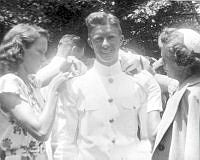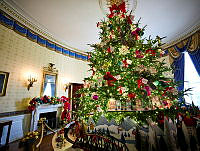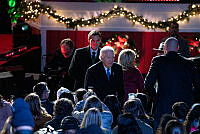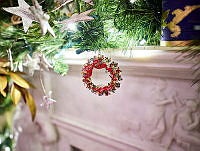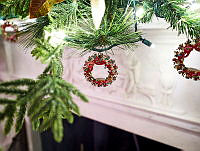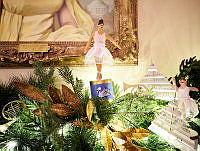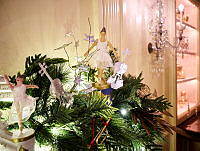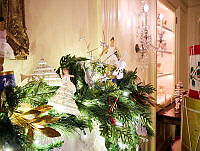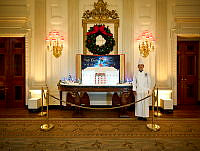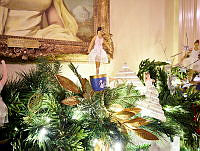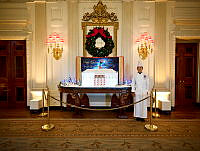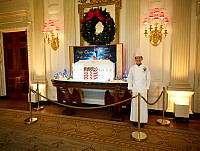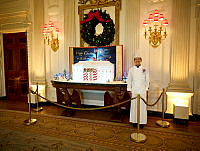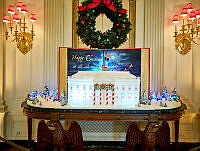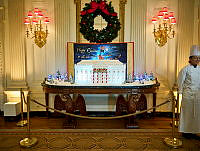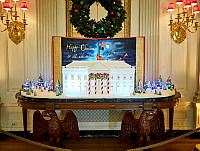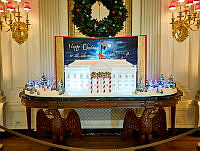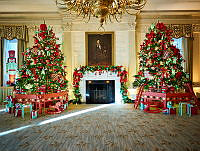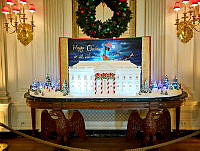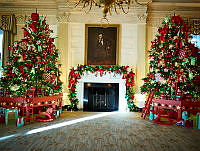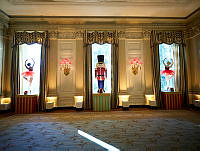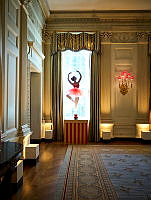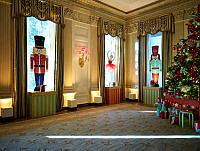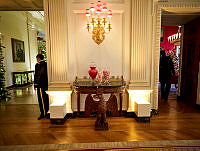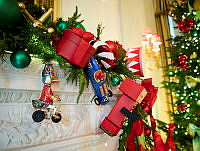Rubenstein Center Scholarship
Thomas Jefferson's Cabinet
On November 26, 1791, Secretary of State Thomas Jefferson attended the first cabinet meeting in American history. At 10:00 am, he arrived at the President’s House on the corner of Sixth and Market Streets in Philadelphia, Pennsylvania. He walked upstairs and entered George Washington’s private study on the second floor. The room was relatively small—fifteen by twenty-one feet—and overcrowded with furniture, including Washington’s large desk that measured over five feet wide, a wrought-iron stove, a dressing table, a globe, and three bookcases. In the center of the room, a small table and chairs were set up for the meeting. Joining Jefferson were Secretary of the Treasury Alexander Hamilton, Secretary of War Henry Knox, and Attorney General Edmund Randolph.1
Over the next two years, Jefferson attended nearly sixty cabinet meetings at the president’s instruction, often in Washington’s small private study. For several hours each day, sometimes five days a week, the secretaries crammed around the small table and debated diplomatic, domestic, and constitutional issues. Jefferson and Hamilton hated each other—they disagreed about everything, from their vision for the future of the nation to their diplomatic alliance preferences.2 Jefferson wanted a nation of yeomen farmers that allied with France, while Hamilton preferred to promote urban trade centers and merchants, which would ally with Great Britain. They frequently clashed in cabinet meetings and Jefferson abhorred the conflict.3

Floor plan of the Executive Mansion during President Thomas Jefferson's residency. Jefferson's private study is in the bottom left corner.
Benjamin Henry Latrobe, The White House (President's House) Washington, D.C., Library of Congress, https://www.loc.gov/item/2001698951.President John Adams was the first chief executive to live in the White House, but not the first to host a cabinet meeting in the Executive Mansion. Adams moved in on November 1, 1800, but after losing in the election of 1800, he returned to Massachusetts a few months later. In March 1801, Jefferson made the building his home and established his official workspace, complete with a library and study to welcome the secretaries.
Once in office, Jefferson relied on his prior cabinet experience to shape his own private study and his interactions with his department secretaries: Secretary of State James Madison, Secretary of the Treasury Albert Gallatin, Secretary of War Henry Dearborn, Secretary of the Navy Robert Smith, and Attorneys General Levi Lincoln, John Breckinridge, and Caesar Rodney.
Jefferson reserved the large room in the southwest corner of the first floor (now known as the State Floor) for his private study. Since then, the room has been expanded and today is known as the State Dining Room. When Jefferson welcomed guests to the Executive Mansion, they typically entered on the north side into the Entrance Hall. Étienne Lemaire, the maître d’hôtel, or manager of the household staff, escorted most guests to the oval drawing room, which is the Blue Room today. If friends, congressmen, or diplomats visited for a special meeting, Jefferson might have welcomed them into his antechamber, to the left of the oval drawing room. This parlor, now the Red Room, was decorated for Jefferson to host select guests. If the department secretaries arrived for a cabinet meeting, however, they passed through the antechamber and into Jefferson’s private study.4
Upon entering the room, the secretaries were met with a room that reflected Jefferson’s priorities, interests, and strengths as president. Large bookcases flanked the walls and the shelves were filled with volumes on science, farming, war, statecraft, literature, and more. A large ladder leaned against the bookcases to provide easy access to the works on higher shelves. Many species of plants, flowers, and clippings lined the windowsills in pots, which Jefferson tended to himself.5

This painting by Peter Waddell depicts how Jefferson's private study might have looked during his presidency.
Peter Waddell for the White House Historical AssociationOn the walls Jefferson hung large maps of the United States, Europe, Asia, and Africa that he had ordered from a European agent. In addition to his ever-growing book collection, the shelves featured skulls, bones, and skins that explorers, including Meriwether Lewis, had sent back from the west. In the corner, a bird cage housed Jefferson’s pet mockingbird, Dick. Jefferson would frequently let the bird fly around the room, perch on his shoulder, and take treats from his lips.6
Jefferson also created a number of workspaces in the room. He had his preferred desk, reading stands, and several long tables covered with a green felt-like fabric. A series of chairs flanked these tables for the secretaries’ use.7
What does this space tell us about Jefferson the president and the cabinet? Jefferson worked hard to cultivate cabinet interactions that avoided the conflict he had experienced as Washington’s secretary of state. He requested cabinet meetings rarely to minimize the chance of conflict and only gathered his secretaries when he felt it was necessary. When the cabinet did convene, he insisted that they meet in his private study.8
Jefferson was particular about this space. First and foremost, he demanded that the space remain private. He permitted only certain illiterate servants to clean the room because he believed those who could read might snoop through his papers.9 While he enjoyed privacy in all aspects of his life, he also wanted to preserve the exclusivity of the room. By limiting who had access to his study, Jefferson ensured that the cabinet members felt like trusted members of his inner circle when he welcomed them to meetings. He also set up permanent, comfortable workspaces for them to utilize during cabinet deliberations. Jefferson disliked Washington’s cramped private study with its temporary table and chairs, so he selected a much larger room for his study and provided more spacious accommodations for his visitors.10

Thomas Jefferson ordered this map of the United States in 1803. He hung it in his private study at the White House, and then in his Entrance Hall at Monticello after he retired.
Aaron Arrowsmith, United States of Nth. America, Library of Congress, https://www.loc.gov/item/98685633/By controlling the meeting space, Jefferson was able to keep close tabs on their conversations, unlike President Washington, who sometimes instructed his secretaries to meet and report back their determination.11 Jefferson trusted his subordinates but did not want them meeting without him, indicating that his leadership style was meticulous, hands-on, and designed to protect presidential authority.
Finally, Jefferson’s private study centralized his authority as president. By keeping the meetings infrequent, Jefferson prevented the cabinet from assuming more authority and expecting to be a part of the decision-making process. Put another way, they could offer advice, even unsolicited advice, but the final decision was Jefferson’s alone. The décor on the walls and shelves reflected his interests, emphasizing that he resided in the Executive Mansion. The map of the Louisiana Territory reminded the secretaries of his greatest triumph as president—the Louisiana Purchase. The secretaries understood the message the room was designed to convey: “Nay I…did not dare to bring forward the measure until I had first obtained his approbation. Never was there a time when executive influence so completely governed the nation.”12
Jefferson’s careful attention to cabinet management paid off. He had the lowest cabinet turnover in United States history, only finding replacements for his attorneys general when they became ill or died. Furthermore, while the secretaries didn’t always agree with Jefferson, they supported his policies, never sought to undermine his agenda, and didn’t compete with him for power. As a result, they served as an incredibly persuasive tool for public outreach, congressional cooperation, and diplomatic negotiations. They worked together on key issues like the Louisiana Purchase in 1803 and the Embargo in 1807 without fracturing like cabinets before or after Jefferson’s presidency.13 Their meeting space in the Executive Mansion—and Jefferson’s ability to manage his subordinates—played an important role in their success.








